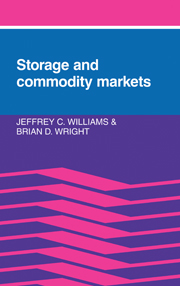Book contents
- Frontmatter
- Contents
- Preface
- Acknowledgments
- 1 Introduction
- Part I The basic model
- 2 Competitive equilibrium with storage
- 3 Solving for the storage equilibrium
- 4 The effects of storage on production, consumption, and prices
- 5 Convergence to the steady state
- Part II Implications of storage for research on time series
- Part III Extensions of the model
- Part IV Public interventions
- Part V Epilogue
- References
- Author index
- Subject index
5 - Convergence to the steady state
Published online by Cambridge University Press: 03 February 2010
- Frontmatter
- Contents
- Preface
- Acknowledgments
- 1 Introduction
- Part I The basic model
- 2 Competitive equilibrium with storage
- 3 Solving for the storage equilibrium
- 4 The effects of storage on production, consumption, and prices
- 5 Convergence to the steady state
- Part II Implications of storage for research on time series
- Part III Extensions of the model
- Part IV Public interventions
- Part V Epilogue
- References
- Author index
- Subject index
Summary
The long-run distributions discussed in Chapter 4 can be imagined as frequency distributions from extremely long time series. Indeed, that is how they were produced. Nevertheless, there is a second way to conceive of and to deduce the stochastic steady state of a system. The stochastic steady state is the probability distribution for a single period some time in the distant future, viewed from the perspective of the current period. One can imagine from the perspective of the current period the probability distribution of, say, consumption period by period into the future. For a nonstorable commodity, the exercise is trivial. Because each future period is just like any other from the perspective of period t, the probability distribution of consumption in period t+ 1 is identical to that in period t + 2, and so on, and also identical to the distribution that would emerge from a long time series. For a storable commodity, however, the probability distributions for the next few periods (t+ 1, t+ 2, etc.) will be sensitive to conditions in period t. Eventually, the distribution for some period ahead, perhaps eight periods ahead, will be nearly the same as that for the previous one (period t + 7) regardless of the initial conditions. That distribution approximates the steady-state distribution.
The focus of the present chapter is understanding the process of convergence to the invariant steady-state distributions as a function of the initial conditions.
- Type
- Chapter
- Information
- Storage and Commodity Markets , pp. 128 - 154Publisher: Cambridge University PressPrint publication year: 1991



